3 ASX rare earths stocks to watch as prices finally show signs of stabilising
For many investors, the performance of rare earths stocks possibly ranks alongside lithium stocks as one of the two key disappointments of the last 18 months. When demand is high and supply is low, the commodity price cycle giveth, but when the opposite occurs the commodity price cycle also taketh away.
Rare earths are a group of 15 elements in the Lanthanide series of the periodic table. They react with other elements to form materials with chemical behaviours which make them indispensable in the electronics, optical, and automotive industries.
It was the rapid growth of the Chinese EV and green energy markets towards the end of the last decade which sparked a massive rise in the prices of many rare earth elements, particularly neodymium and praseodymium (the combination is commonly referred to as "NdPr"). This surge occurred around the same time supply was in the doldrums due to a period of very low market pricing.
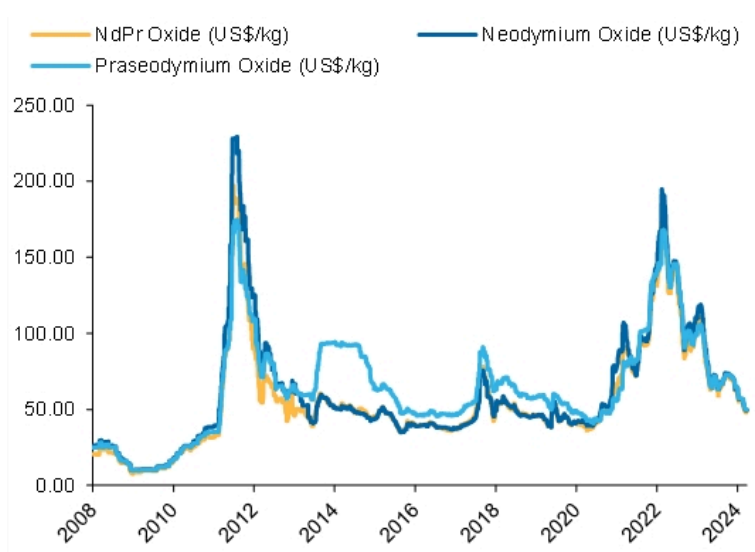
The chart above shows the rapid rise and fall of NdPr prices. Since the turn of the decade, the global mining industry, particularly within China, capitalised on the opportunity created by the price spike by increasing production.
China now controls around 70% of the world’s rare earths production and processing. Its rare earths industry has grown at over 20% per year each year since 2020, and this increase in supply has been a major factor in damping prices.
China rare earths industry consolidation “complete”
According to major broker Macquarie, over this period China has moved to consolidate its dominance of the sector by restructuring industry players into two major ones, China Northern Rare Earths (CNRE) which is focussed on producing light rare earths, and China Rare Earth Resources and Technology which is focussed on producing heavy rare earths.
Macquarie suggests the consolidation is now “complete”. Additionally, plant utilisation rates at the two remaining major producers are now nearing installed capacity. This means that the likelihood of further major ramp-ups in production is diminishing, and “this could limit supply growth in the absence of capital”, suggests the broker.
Macquarie contends that we might be at the early stage of a potential “stabilisation” in the NdPr price. They note that CNRE has guided its sales price lower every month this year due to what it called “soft demand”. But, in its most recent April update, CNRE decided to keep its April price forecast flat at US$50.60/kg.
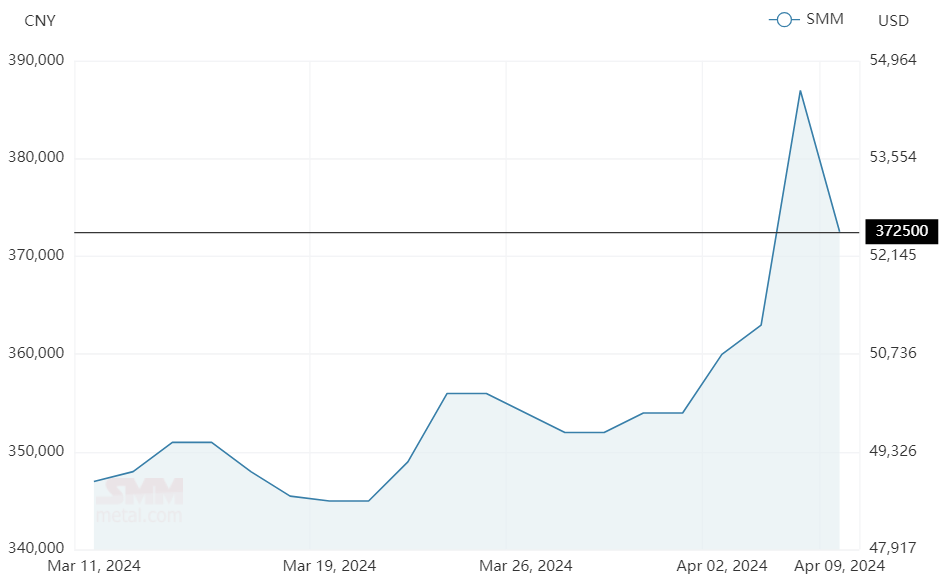
NdPR prices reached a multi-year low of $US48/kg last month, and according to Chinese metals market information provider SMM, bounced back to as high as US$54/kg on Monday. Yesterday, they pulled back to around US$52/kg.
But is this the low? Only time will tell. But as far as commodity price cycles go, that is, low prices typically equate to underinvestment in future production, Macquarie notes “limited capital has been allocated to greenfield or brownfield expansions” over the past two years. In theory, underinvestment against consistently growing demand should sow the seeds for the next price expansion.
It’s just how commodity price cycles have worked since Adam was a little boy.
On the demand side, I note a recent comment in a research report from UBS which believes that while the short-term outlook for rare earths pricing is “challenged”, in the longer term, demand is expected to be robust. The broker notes the EV and wind power generation industries will make up around 40% of global demand by 2030 and will assist in achieving a 9% compound annual growth rate in rare earths demand until then.
It may take a considerable amount of time for the market to rebalance, and back to Macquarie here, who concedes the “rare earths market is very opaque”. Still, there’s no harm in checking out one’s options in terms of ASX-listed rare earths producers on, so far, what is just a hint a major low is in!
ASX rare earths stocks to watch if prices have stabilised
Here are your three main options. I have chosen to focus on producers or those with a clear path to imminent production only. This is because they’re the most likely to take advantage of any near-term bounce in rare earths minerals prices.
Lynas Rare Earths (LYC: ASX)
Lynas Rare Earths is one of the largest non-China aligned rare earths producers globally. It operates the Mt Weld Mine in Western Australia, a processing plant in Malaysia, and the recently commissioned processing facility in Kalgoorlie. It also has a development project in Texas which is partly funded by the US Government, where production is targeted for 2027.
The addition of the Kalgoorlie plant should help Lynas increase its production capacity from 7kt p.a. to 12kt p.a. NdPr by 2025. To put this into perspective, Lynas’ current production as per its December quarterly update was 3.6Mt.
The Mt Weld mine is a resource of major global importance, hosting a particularly high-grade deposit. Mineral Reserves are 18.3Mt @ 8.3% total rare earth oxides (TREO) and Mineral Resources are 54.5Mt @ 5.3% TREO with significant resource upside.
Broker consensus
Average PT $6.60; Upside from current price to average PT +10.6%
- Macquarie OUTPERFORM, PT $7.00 (9 Apr)
- JP Morgan NEUTRAL, PT $5.00 (8 Apr)
- Morgan Stanley UNDERWEIGHT, PT $5.00 (2 Apr)
- UBS BUY, PT$6.90 (19 Mar)
- Goldman Sachs BUY, PT $7.40 (5 Mar)
- Bell Potter BUY, PT $7.20 (27 Feb)
- Citi NEUTRAL, PT $6.70 (27 Feb)
- Jefferies BUY, PT $7.60 (6 Feb)
Price history
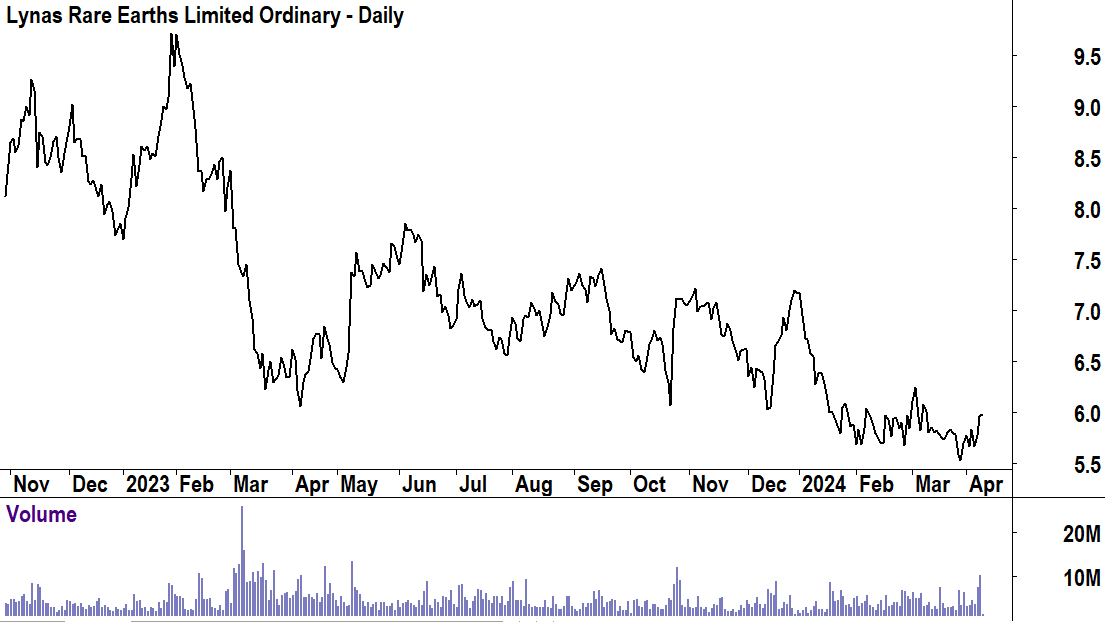.png)
Iluka Resources (ASX: ILU)
Iluka is a globally significant producer of mineral sands, particularly zircon and high-grade titanium dioxide feedstocks such as rutile and synthetic rutile. It also owns 20% of Deterra Royalties which gives it considerable iron ore exposure as well.
Iluka also has significant rare earths aspirations. It’s currently developing its Eneabba rare earths refinery which will process the company’s existing stockpile of monazite as well as feed from future projects and potentially even third-party rare earths producers.
According to Iluka, Eneabba will enable it to become “a globally material supplier of separated rare earth oxides”. The refinery is currently under construction, and when completed in 2026, will have a total annual production capacity of up to 23,000 tonnes of rare earth oxides.
Broker consensus
Average PT $7.99; Upside from current price to average PT +8.9%
- Macquarie NEUTRAL, PT $7.00 (9 Apr)
- Ord Minnett ACCUMULATE, PT $9.50 (8 Apr)
- Morgan Stanley EQUAL-WEIGHT, PT $7.20 (2 Apr)
- Citi NEUTRAL, PT $7.70 (19 Mar)
- UBS NEUTRAL, PT $7.50 (19 Mar)
- Bank of America UNDERPERFORM, PT $6.85 (23 Feb)
- Barrenjoey OVERWEIGHT, PT $8.40 (22 Feb)
- Goldman Sachs BUY, PT $9.80 (13 Feb)
Price history
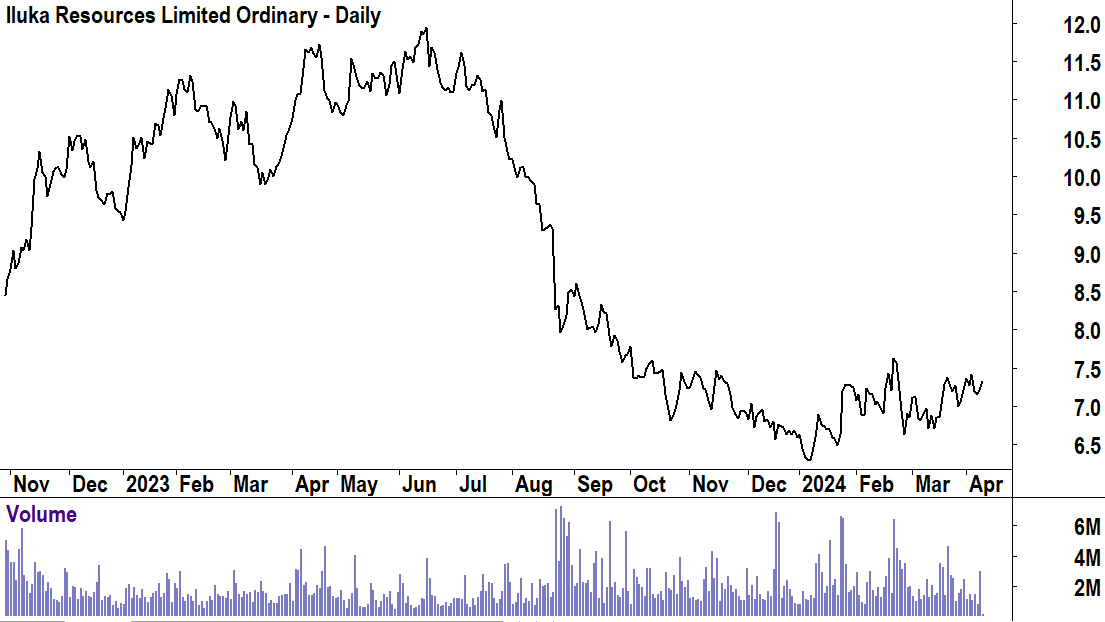.png)
Arafura Rare Earths (ASX: ARU)
Arafura is developing its Nolans project, located in the Northern Territory. Nolans contains Mineral Resources of 56Mt at 2.6% TREO and Ore Reserves of 29.5Mt at 2.9% TREO.
Once in production, Arafura aims to achieve a production rate of 4.44kt p.a. NdPr over a projected mine life of 38 years. According to the company, once up and running, Nolans could supply approximately 5-10% of the world’s rare earths needs.
Arafura has secured several binding offtake agreements covering just under half of the project’s nameplate capacity with the likes of Hyundai, Kiai, and Siemens. It is still working on securing the bulk of the balance, along with crucial project financing, and commissioning. It is unlikely that Nolans will be in production until early 2027.
Broker consensus
Average PT $0.165; Upside from current price to average PT -15.4%
- JP Morgan UNDERWEIGHT, PT $0.14 (8 Apr)
- Bell Potter BUY, PT $0.19 (20 Mar)
Price history
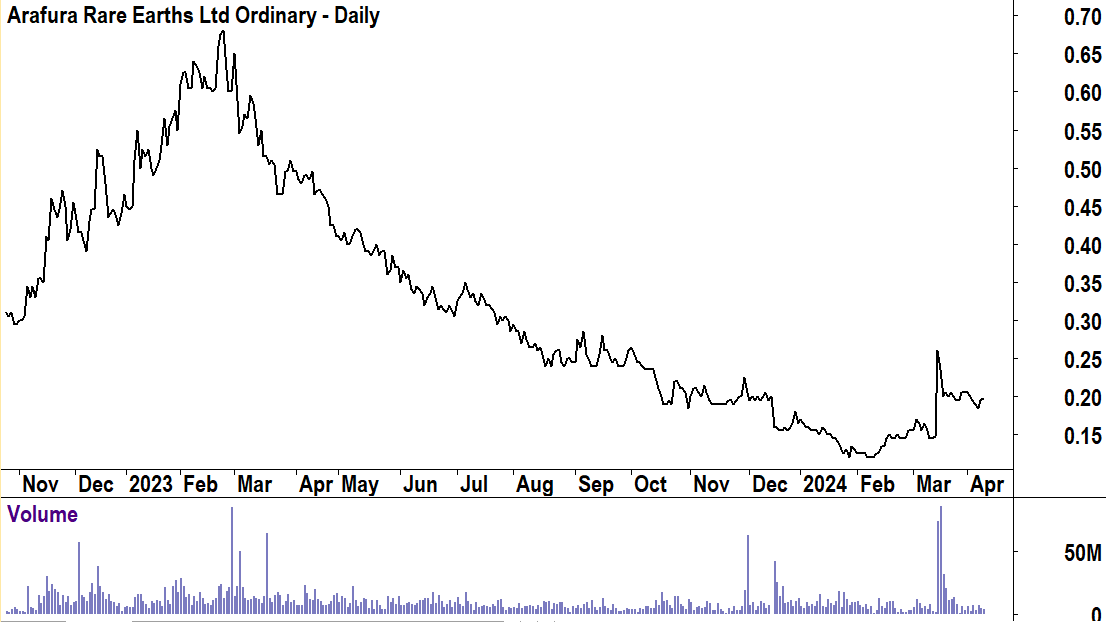.png)
Major brokers’ NdPr forecasts
I’ll leave you with a compilation of the latest forecasts for NdPr prices from several major brokers for 2024, 2025, and beyond:
- Bank of America 2024: US$66/kg
- Citi 2024: US$57.40/kg; 2025 US$76.30/kg
- Goldman Sachs 2024: US$60/kg; “Long run”: US$83/kg
- Morgan Stanley 2024: US$55/kg; 2025: US$71/kg
- UBS “Long term”: US$75/kg
This article first appeared on Market Index on Wednesday 10 April 2024.
5 topics
3 stocks mentioned

